Hyundai Equus 2016 Owner's Manual
Manufacturer: HYUNDAI, Model Year: 2016, Model line: Equus, Model: Hyundai Equus 2016Pages: 477, PDF Size: 16.25 MB
Page 261 of 477
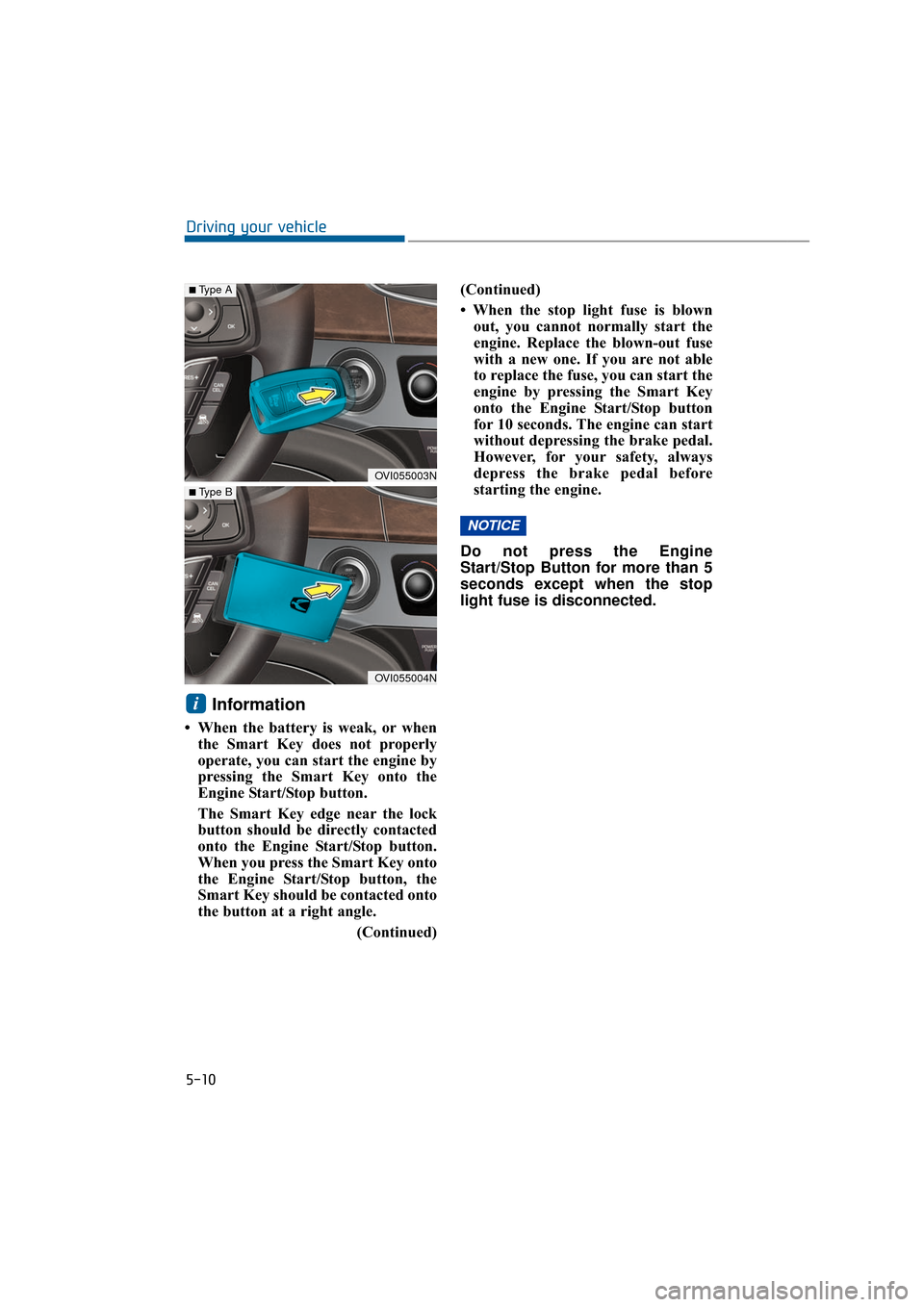
Information
• When the battery is weak, or whenthe Smart Key does not properly
operate, you can start the engine by
pressing the Smart Key onto the
Engine Start/Stop button.
The Smart Key edge near the lock
button should be directly contacted
onto the Engine Start/Stop button.
When you press the Smart Key onto
the Engine Start/Stop button, the
Smart Key should be contacted onto
the button at a right angle.
(Continued)(Continued)
• When the stop light fuse is blown
out, you cannot normally start the
engine. Replace the blown-out fuse
with a new one. If you are not able
to replace the fuse, you can start the
engine by pressing the Smart Key
onto the Engine Start/Stop button
for 10 seconds. The engine can start
without depressing the brake pedal.
However, for your safety, always
depress the brake pedal before
starting the engine.
Do not press the Engine
Start/Stop Button for more than 5
seconds except when the stop
light fuse is disconnected.
NOTICE
i
5-10
Driving your vehicle
OVI055003N
■Type A
OVI055004N
■ Type B
Page 262 of 477
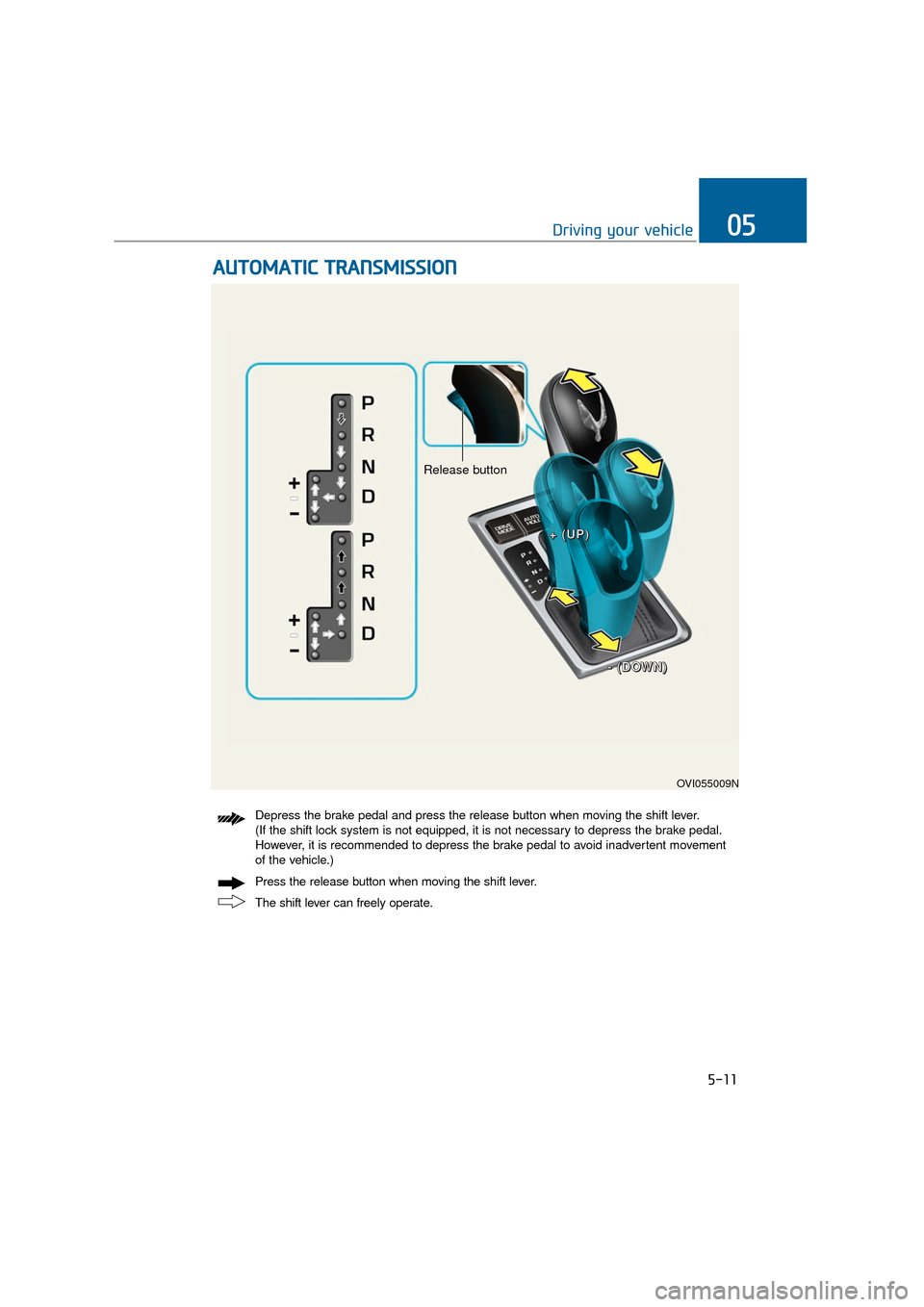
A
AU
U T
TO
O M
M A
AT
TI
IC
C
T
T R
R A
A N
N S
SM
M I
IS
S S
SI
IO
O N
N
5-11
Driving your vehicle05
OVI055009N
+
+
+
+
(
(
(
(
U
U
U
U
P
P
P
P
)
)
)
)
Release button
-
-
-
-
(
(
(
(
D
D
D
D
O
O
O
O
W
W
W
W
N
N
N
N
)
)
)
)
The shift lever can freely operate. Press the release b
utton when moving the shift lever.
Depress the brake pedal and press the release button when moving the shift lever.
(If the shift lock system is not equipped, it is not necessary to depress the brake pedal.
However, it is recommended to depress the brake pedal to avoid inadvertent movement
of the vehicle.)
Page 263 of 477
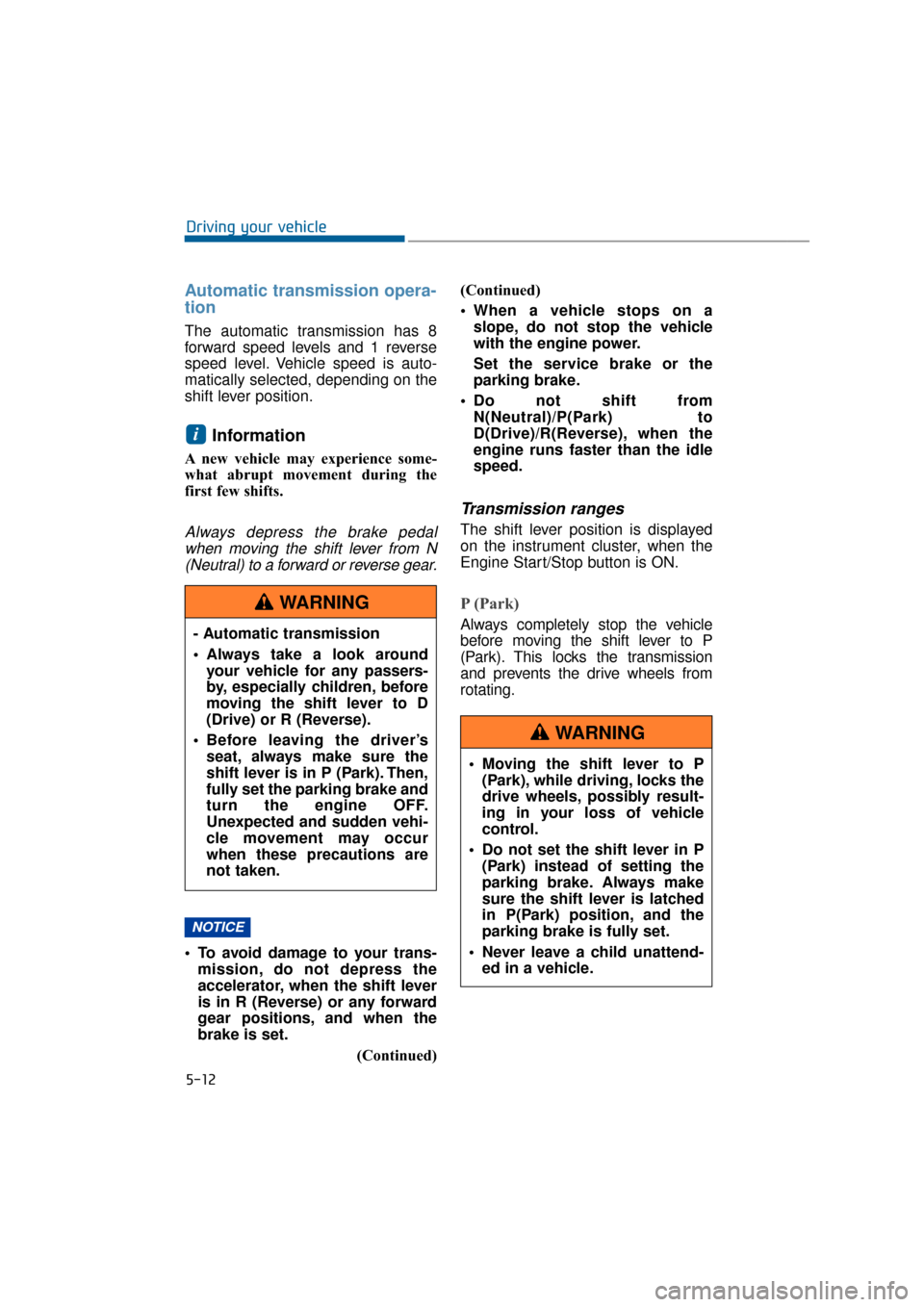
Automatic transmission opera-
tion
The automatic transmission has 8
forward speed levels and 1 reverse
speed level. Vehicle speed is auto-
matically selected, depending on the
shift lever position.
Information
A new vehicle may experience some-
what abrupt movement during the
first few shifts.
Always depress the brake pedalwhen moving the shift lever from N(Neutral) to a forward or reverse gear.
To avoid damage to your trans- mission, do not depress the
accelerator, when the shift lever
is in R (Reverse) or any forward
gear positions, and when the
brake is set.
(Continued)(Continued)
When a vehicle stops on a
slope, do not stop the vehicle
with the engine power.
Set the service brake or the
parking brake.
Do not shift from N(Neutral)/P(Park) to
D(Drive)/R(Reverse), when the
engine runs faster than the idle
speed.
Transmission ranges
The shift lever position is displayed
on the instrument cluster, when the
Engine Start/Stop button is ON.
P (Park)
Always completely stop the vehicle
before moving the shift lever to P
(Park). This locks the transmission
and prevents the drive wheels from
rotating.
NOTICE
i
5-12
Driving your vehicle
- Automatic transmission
Always take a look around your vehicle for any passers-
by, especially children, before
moving the shift lever to D
(Drive) or R (Reverse).
Before leaving the driver’s seat, always make sure the
shift lever is in P (Park). Then,
fully set the parking brake and
turn the engine OFF.
Unexpected and sudden vehi-
cle movement may occur
when these precautions are
not taken.
WARNING
Moving the shift lever to P(Park), while driving, locks the
drive wheels, possibly result-
ing in your loss of vehicle
control.
Do not set the shift lever in P (Park) instead of setting the
parking brake. Always make
sure the shift lever is latched
in P(Park) position, and the
parking brake is fully set.
Never leave a child unattend- ed in a vehicle.
WARNING
Page 264 of 477
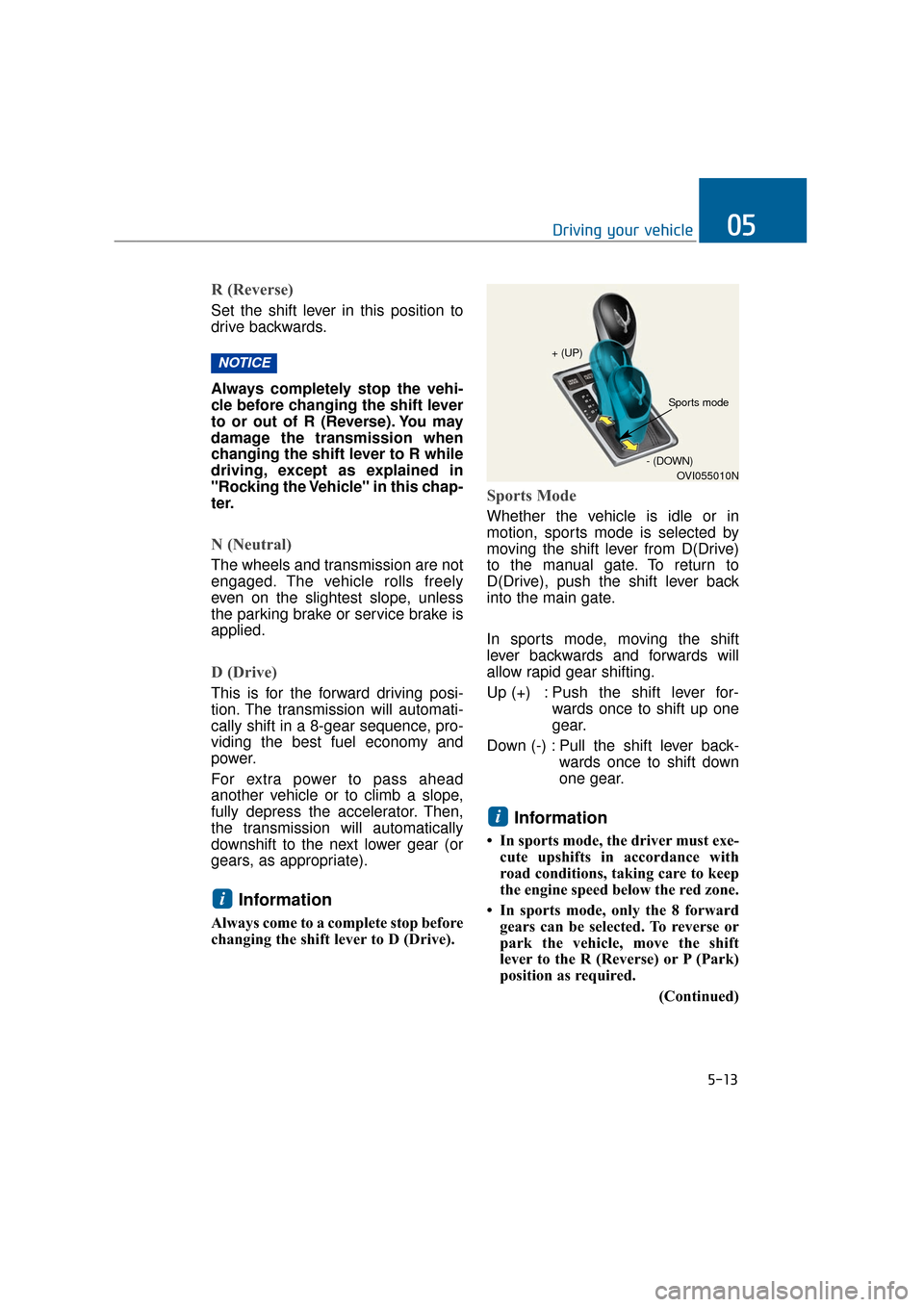
R (Reverse)
Set the shift lever in this position to
drive backwards.
Always completely stop the vehi-
cle before changing the shift lever
to or out of R (Reverse). You may
damage the transmission when
changing the shift lever to R while
driving, except as explained in
"Rocking the Vehicle" in this chap-
ter.
N (Neutral)
The wheels and transmission are not
engaged. The vehicle rolls freely
even on the slightest slope, unless
the parking brake or service brake is
applied.
D (Drive)
This is for the forward driving posi-
tion. The transmission will automati-
cally shift in a 8-gear sequence, pro-
viding the best fuel economy and
power.
For extra power to pass ahead
another vehicle or to climb a slope,
fully depress the accelerator. Then,
the transmission will automatically
downshift to the next lower gear (or
gears, as appropriate).
Information
Always come to a complete stop before
changing the shift lever to D (Drive).
Sports Mode
Whether the vehicle is idle or in
motion, sports mode is selected by
moving the shift lever from D(Drive)
to the manual gate. To return to
D(Drive), push the shift lever back
into the main gate.
In sports mode, moving the shift
lever backwards and forwards will
allow rapid gear shifting.
Up (+) : Push the shift lever for-wards once to shift up one
gear.
Down (-) : Pull the shift lever back- wards once to shift down
one gear.
Information
• In sports mode, the driver must exe-cute upshifts in accordance with
road conditions, taking care to keep
the engine speed below the red zone.
• In sports mode, only the 8 forward gears can be selected. To reverse or
park the vehicle, move the shift
lever to the R (Reverse) or P (Park)
position as required.
(Continued)
i
i
NOTICE
5-13
Driving your vehicle05
OVI055010N
+ (UP)
- (DOWN)
Sports mode
Page 265 of 477
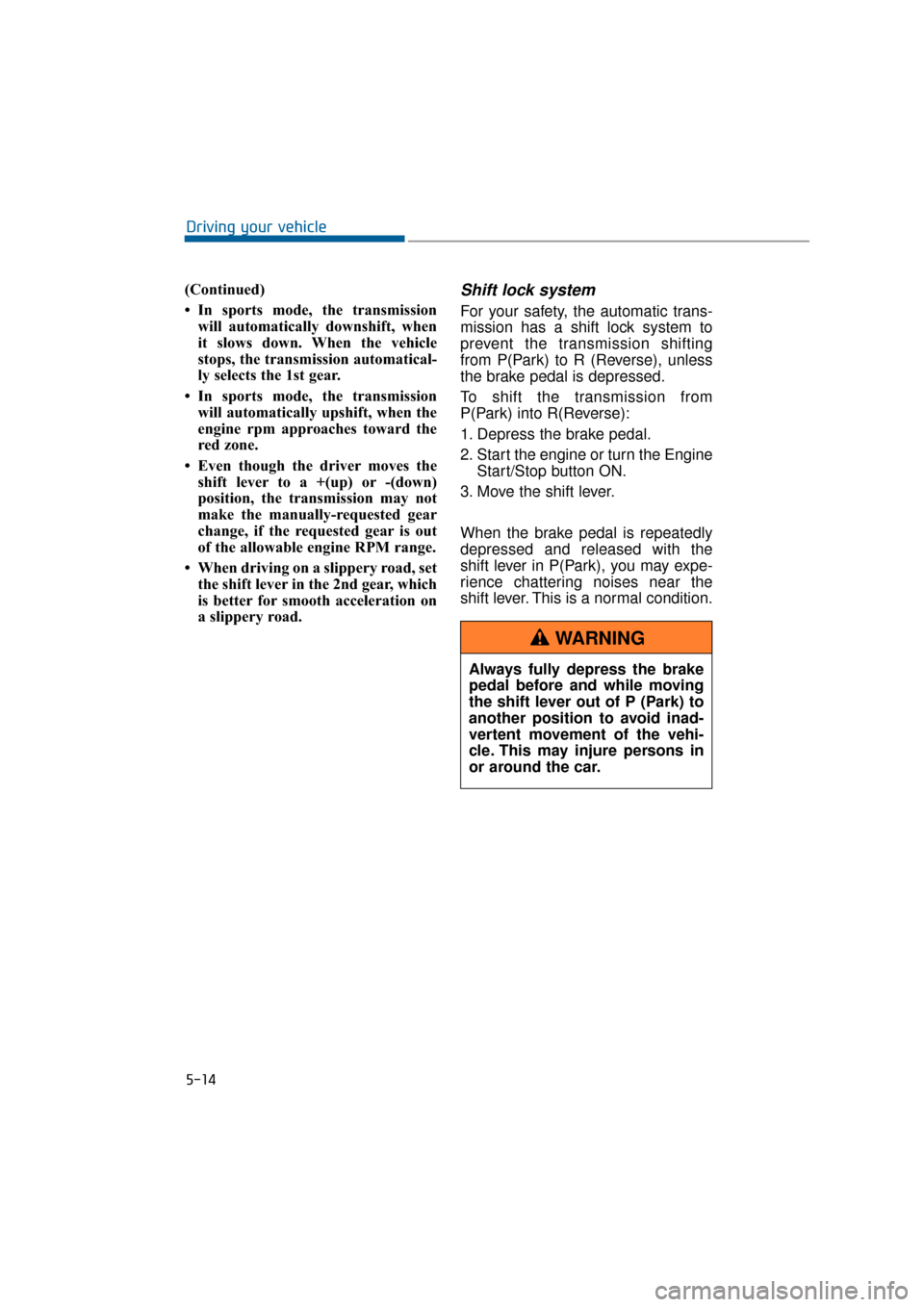
(Continued)
• In sports mode, the transmissionwill automatically downshift, when
it slows down. When the vehicle
stops, the transmission automatical-
ly selects the 1st gear.
• In sports mode, the transmission will automatically upshift, when the
engine rpm approaches toward the
red zone.
• Even though the driver moves the shift lever to a +(up) or -(down)
position, the transmission may not
make the manually-requested gear
change, if the requested gear is out
of the allowable engine RPM range.
• When driving on a slippery road, set the shift lever in the 2nd gear, which
is better for smooth acceleration on
a slippery road.Shift lock system
For your safety, the automatic trans-
mission has a shift lock system to
prevent the transmission shifting
from P(Park) to R (Reverse), unless
the brake pedal is depressed.
To shift the transmission from
P(Park) into R(Reverse):
1. Depress the brake pedal.
2. Start the engine or turn the Engine Start/Stop button ON.
3. Move the shift lever.
When the brake pedal is repeatedly
depressed and released with the
shift lever in P(Park), you may expe-
rience chattering noises near the
shift lever. This is a normal condition.
5-14
Driving your vehicle
Always fully depress the brake
pedal before and while moving
the shift lever out of P (Park) to
another position to avoid inad-
vertent movement of the vehi-
cle. This may injure persons in
or around the car.
WARNING
Page 266 of 477
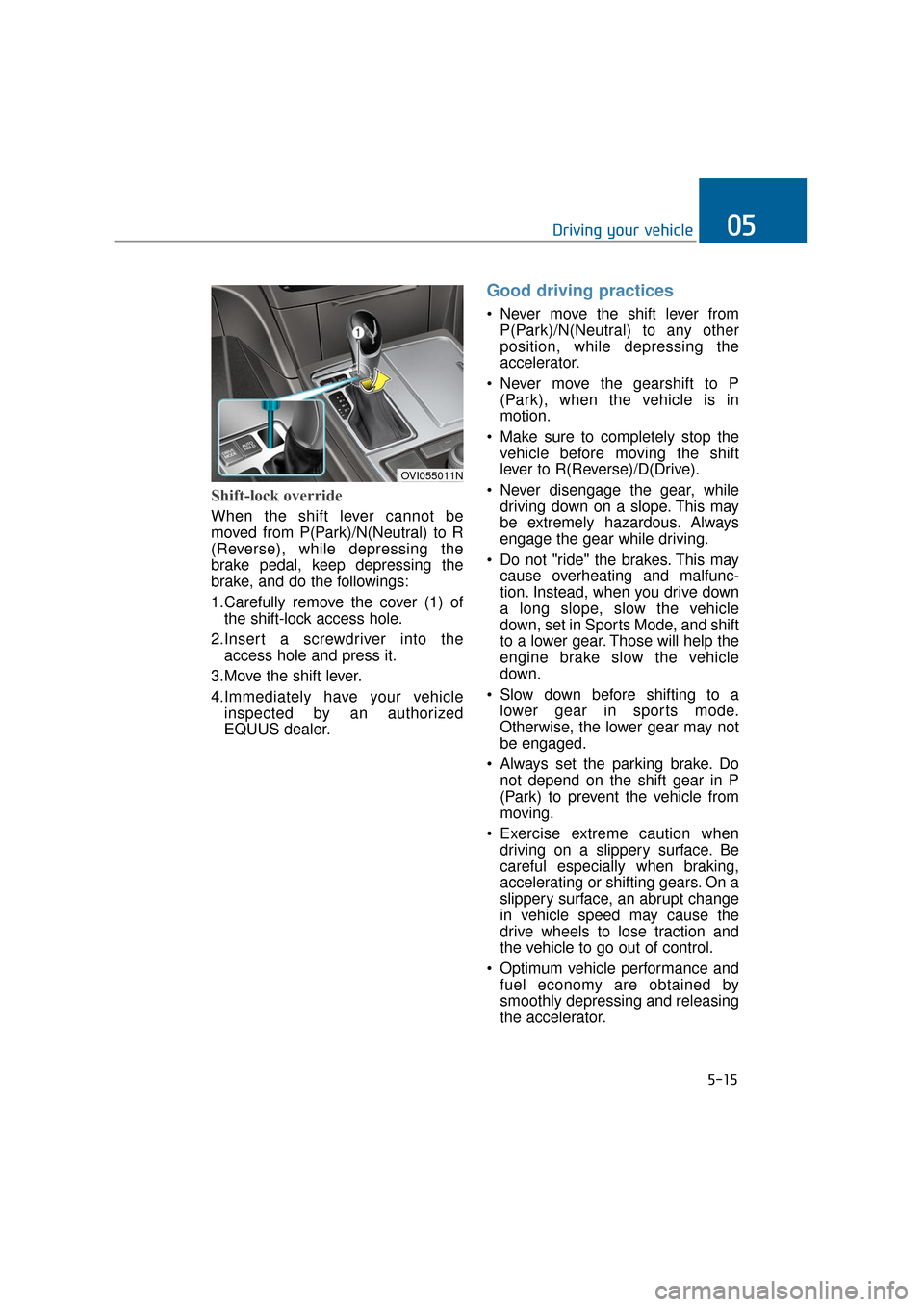
Shift-lock override
When the shift lever cannot be
moved from P(Park)/N(Neutral) to R
(Reverse), while depressing the
brake pedal, keep depressing the
brake, and do the followings:
1.Carefully remove the cover (1) ofthe shift-lock access hole.
2.Insert a screwdriver into the access hole and press it.
3.Move the shift lever.
4.Immediately have your vehicle inspected by an authorized
EQUUS dealer.
Good driving practices
Never move the shift lever fromP(Park)/N(Neutral) to any other
position, while depressing the
accelerator.
Never move the gearshift to P (Park), when the vehicle is in
motion.
Make sure to completely stop the vehicle before moving the shift
lever to R(Reverse)/D(Drive).
Never disengage the gear, while driving down on a slope. This may
be extremely hazardous. Always
engage the gear while driving.
Do not "ride" the brakes. This may cause overheating and malfunc-
tion. Instead, when you drive down
a long slope, slow the vehicle
down, set in Sports Mode, and shift
to a lower gear. Those will help the
engine brake slow the vehicle
down.
Slow down before shifting to a lower gear in sports mode.
Otherwise, the lower gear may not
be engaged.
Always set the parking brake. Do not depend on the shift gear in P
(Park) to prevent the vehicle from
moving.
Exercise extreme caution when driving on a slippery surface. Be
careful especially when braking,
accelerating or shifting gears. On a
slippery surface, an abrupt change
in vehicle speed may cause the
drive wheels to lose traction and
the vehicle to go out of control.
Optimum vehicle performance and fuel economy are obtained by
smoothly depressing and releasing
the accelerator.
5-15
Driving your vehicle05
OVI055011N
Page 267 of 477
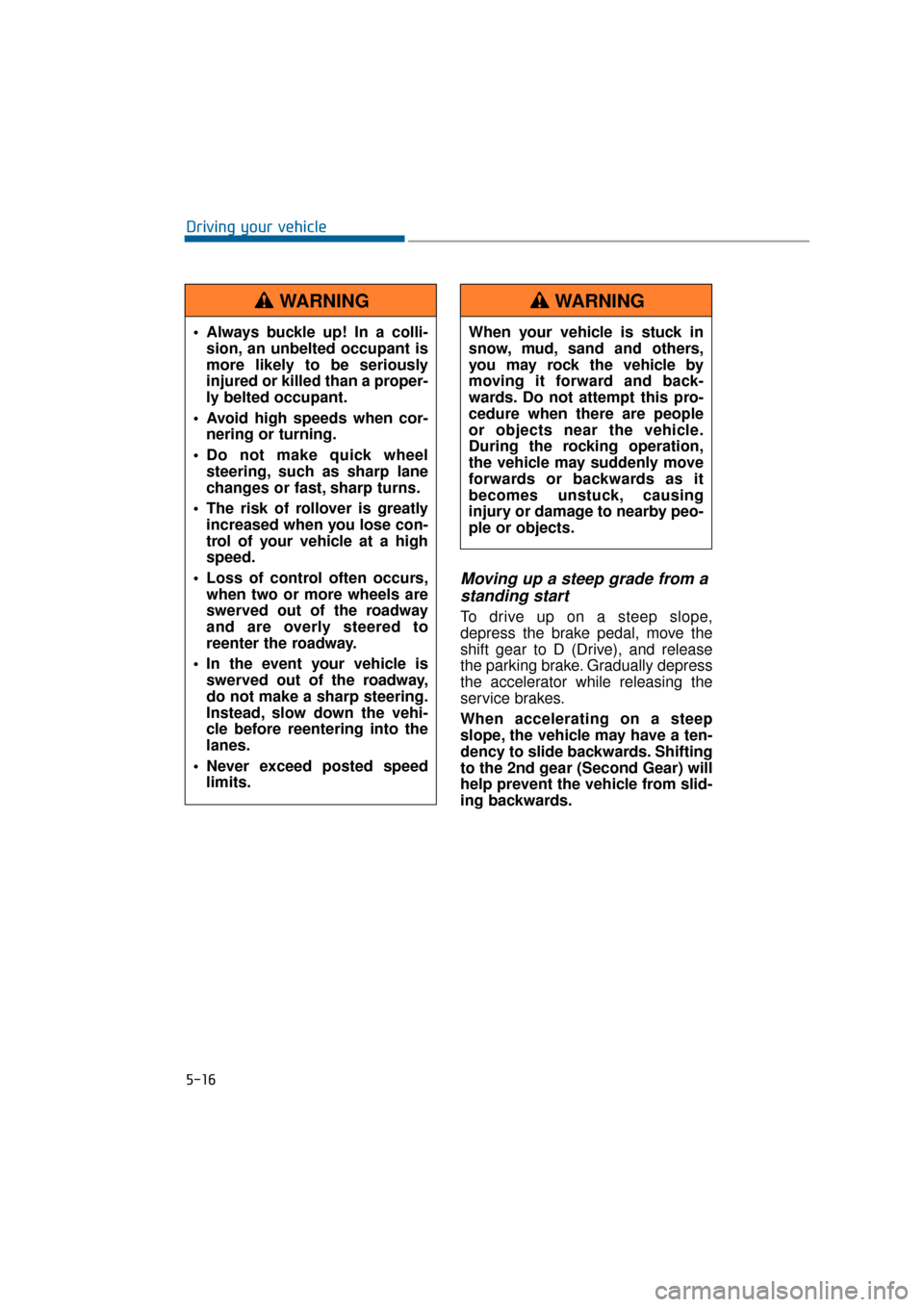
Moving up a steep grade from astanding start
To drive up on a steep slope,
depress the brake pedal, move the
shift gear to D (Drive), and release
the parking brake. Gradually depress
the accelerator while releasing the
service brakes.
When accelerating on a steep
slope, the vehicle may have a ten-
dency to slide backwards. Shifting
to the 2nd gear (Second Gear) will
help prevent the vehicle from slid-
ing backwards.
5-16
Driving your vehicle
Always buckle up! In a colli- sion, an unbelted occupant is
more likely to be seriously
injured or killed than a proper-
ly belted occupant.
Avoid high speeds when cor- nering or turning.
Do not make quick wheel steering, such as sharp lane
changes or fast, sharp turns.
The risk of rollover is greatly increased when you lose con-
trol of your vehicle at a high
speed.
Loss of control often occurs, when two or more wheels are
swerved out of the roadway
and are overly steered to
reenter the roadway.
In the event your vehicle is swerved out of the roadway,
do not make a sharp steering.
Instead, slow down the vehi-
cle before reentering into the
lanes.
Never exceed posted speed limits.
WARNING
When your vehicle is stuck in
snow, mud, sand and others,
you may rock the vehicle by
moving it forward and back-
wards. Do not attempt this pro-
cedure when there are people
or objects near the vehicle.
During the rocking operation,
the vehicle may suddenly move
forwards or backwards as it
becomes unstuck, causing
injury or damage to nearby peo-
ple or objects.
WARNING
Page 268 of 477
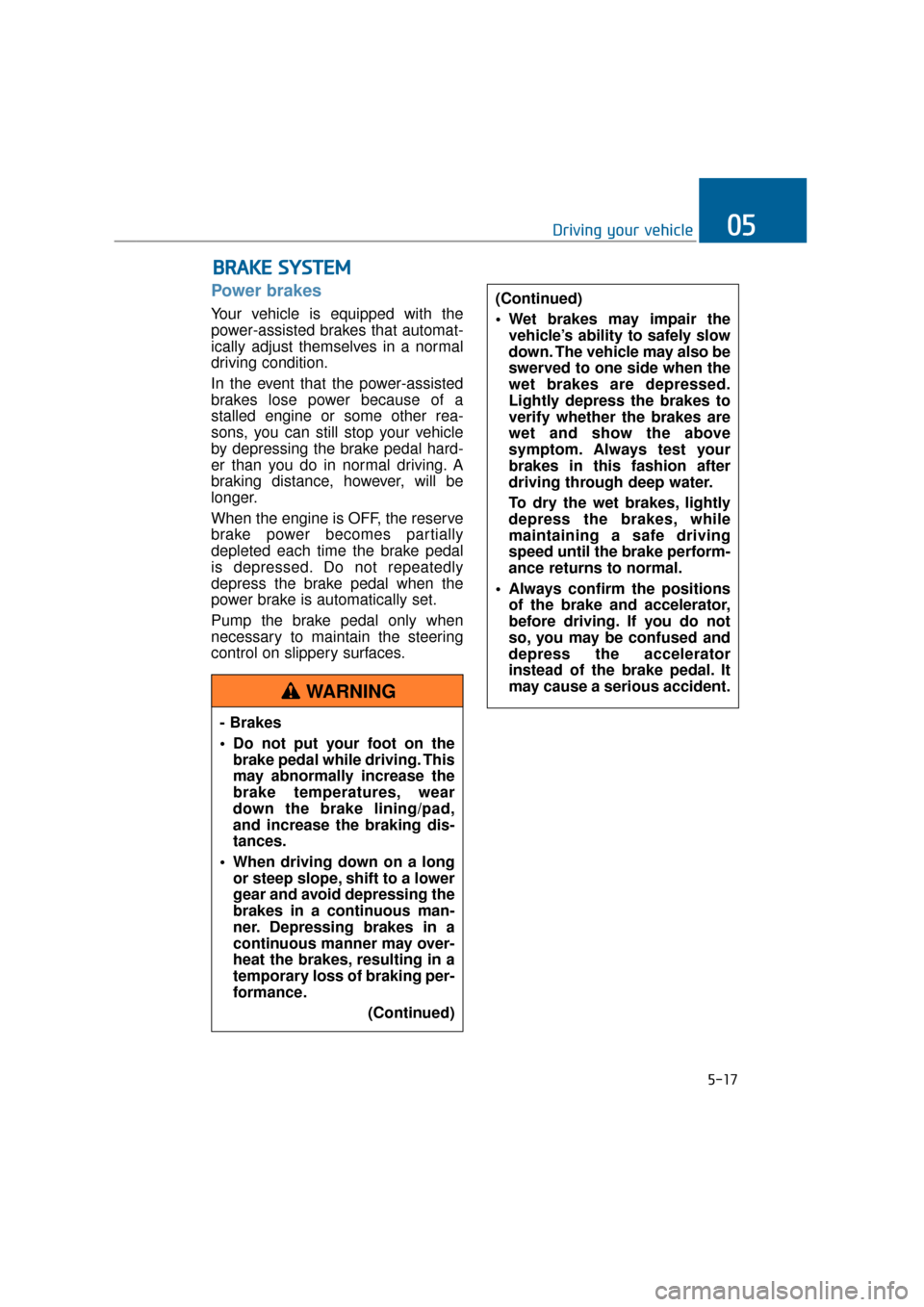
Power brakes
Your vehicle is equipped with the
power-assisted brakes that automat-
ically adjust themselves in a normal
driving condition.
In the event that the power-assisted
brakes lose power because of a
stalled engine or some other rea-
sons, you can still stop your vehicle
by depressing the brake pedal hard-
er than you do in normal driving. A
braking distance, however, will be
longer.
When the engine is OFF, the reserve
brake power becomes partially
depleted each time the brake pedal
is depressed. Do not repeatedly
depress the brake pedal when the
power brake is automatically set.
Pump the brake pedal only when
necessary to maintain the steering
control on slippery surfaces.
B BR
RA
A K
KE
E
S
S Y
Y S
ST
T E
EM
M
5-17
Driving your vehicle05
- Brakes
Do not put your foot on the
brake pedal while driving. This
may abnormally increase the
brake temperatures, wear
down the brake lining/pad,
and increase the braking dis-
tances.
When driving down on a long or steep slope, shift to a lower
gear and avoid depressing the
brakes in a continuous man-
ner. Depressing brakes in a
continuous manner may over-
heat the brakes, resulting in a
temporary loss of braking per-
formance.
(Continued)
(Continued)
Wet brakes may impair thevehicle’s ability to safely slow
down. The vehicle may also be
swerved to one side when the
wet brakes are depressed.
Lightly depress the brakes to
verify whether the brakes are
wet and show the above
symptom. Always test your
brakes in this fashion after
driving through deep water.
To dry the wet brakes, lightly
depress the brakes, while
maintaining a safe driving
speed until the brake perform-
ance returns to normal.
Always confirm the positions of the brake and accelerator,
before driving. If you do not
so, you may be confused and
depress the accelerator
instead of the brake pedal. It
may cause a serious accident.
WARNING
Page 269 of 477
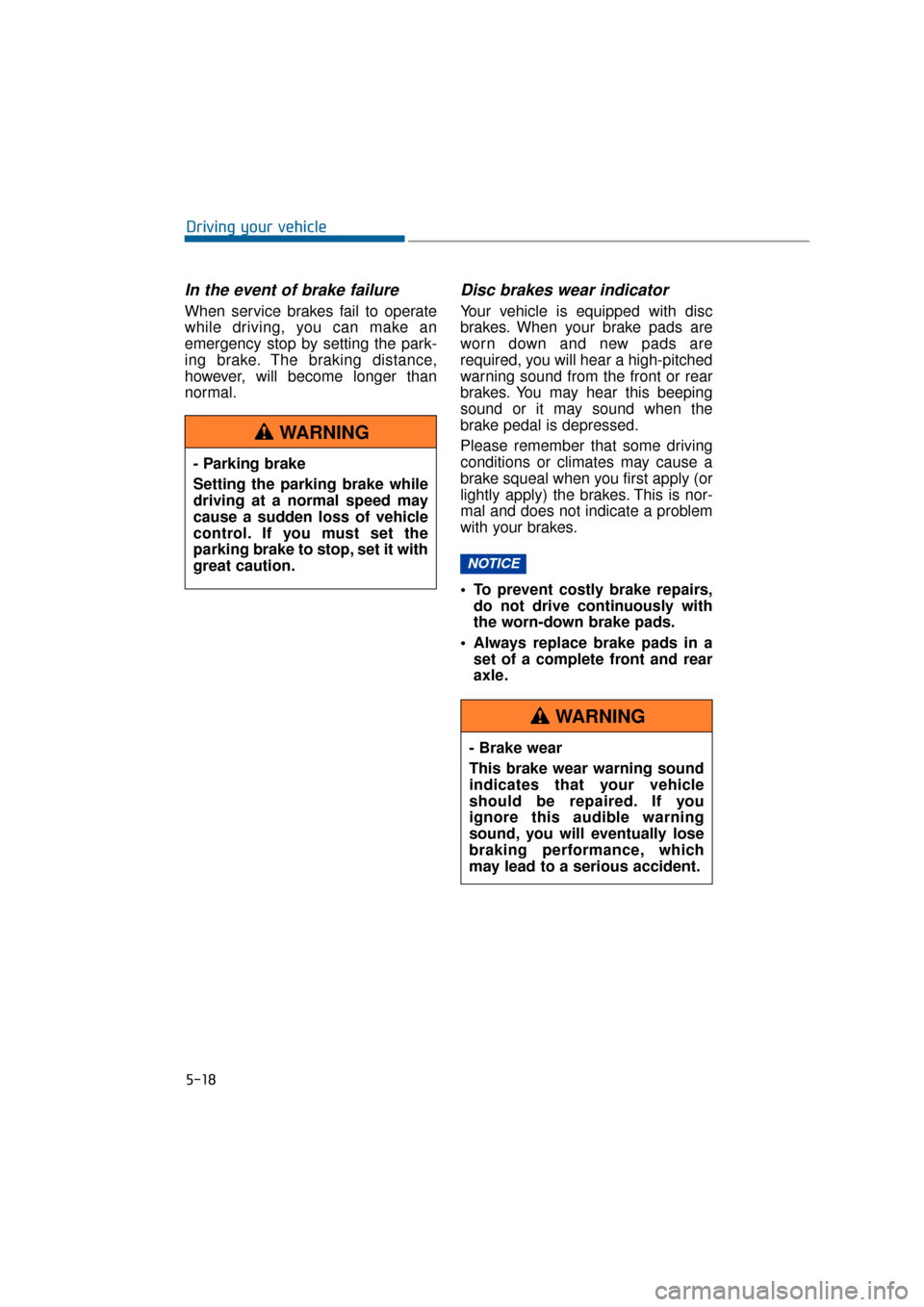
In the event of brake failure
When service brakes fail to operate
while driving, you can make an
emergency stop by setting the park-
ing brake. The braking distance,
however, will become longer than
normal.
Disc brakes wear indicator
Your vehicle is equipped with disc
brakes. When your brake pads are
worn down and new pads are
required, you will hear a high-pitched
warning sound from the front or rear
brakes. You may hear this beeping
sound or it may sound when the
brake pedal is depressed.
Please remember that some driving
conditions or climates may cause a
brake squeal when you first apply (or
lightly apply) the brakes. This is nor-
mal and does not indicate a problem
with your brakes.
To prevent costly brake repairs,do not drive continuously with
the worn-down brake pads.
Always replace brake pads in a set of a complete front and rear
axle.
NOTICE
5-18
Driving your vehicle
- Parking brake
Setting the parking brake while
driving at a normal speed may
cause a sudden loss of vehicle
control. If you must set the
parking brake to stop, set it with
great caution.
WARNING
- Brake wear
This brake wear warning sound
indicates that your vehicle
should be repaired. If you
ignore this audible warning
sound, you will eventually lose
braking performance, which
may lead to a serious accident.
WARNING
Page 270 of 477
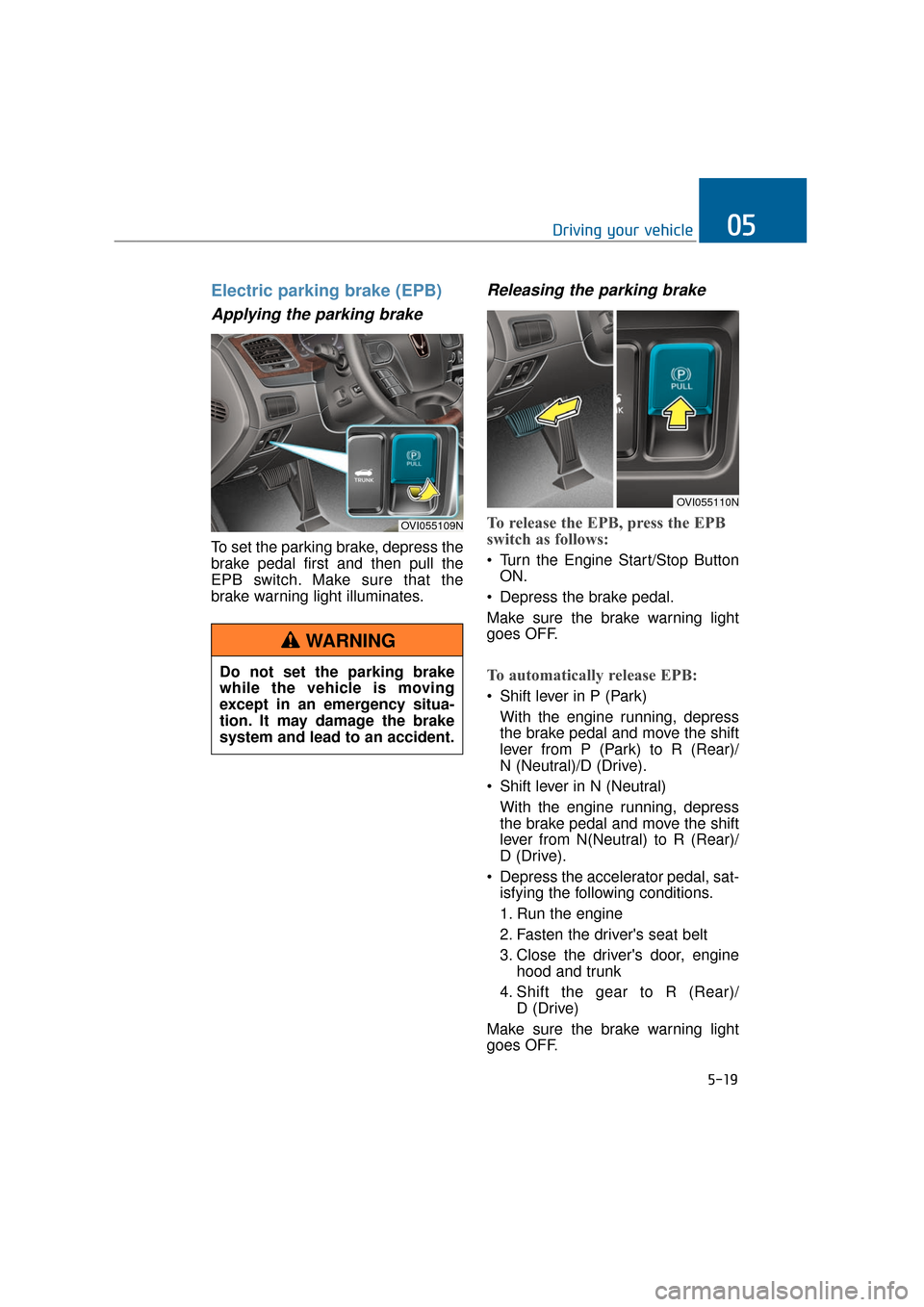
Electric parking brake (EPB)
Applying the parking brake
To set the parking brake, depress the
brake pedal first and then pull the
EPB switch. Make sure that the
brake warning light illuminates.
Releasing the parking brake
To release the EPB, press the EPB
switch as follows:
Turn the Engine Start/Stop ButtonON.
Depress the brake pedal.
Make sure the brake warning light
goes OFF.
To automatically release EPB:
Shift lever in P (Park) With the engine running, depress
the brake pedal and move the shift
lever from P (Park) to R (Rear)/
N (Neutral)/D (Drive).
Shift lever in N (Neutral) With the engine running, depress
the brake pedal and move the shift
lever from N(Neutral) to R (Rear)/
D (Drive).
Depress the accelerator pedal, sat- isfying the following conditions.
1. Run the engine
2. Fasten the driver's seat belt
3. Close the driver's door, engine hood and trunk
4. Shift the gear to R (Rear)/ D (Drive)
Make sure the brake warning light
goes OFF.
5-19
Driving your vehicle05
Do not set the parking brake
while the vehicle is moving
except in an emergency situa-
tion. It may damage the brake
system and lead to an accident.
WARNING
OVI055110N
OVI055109N